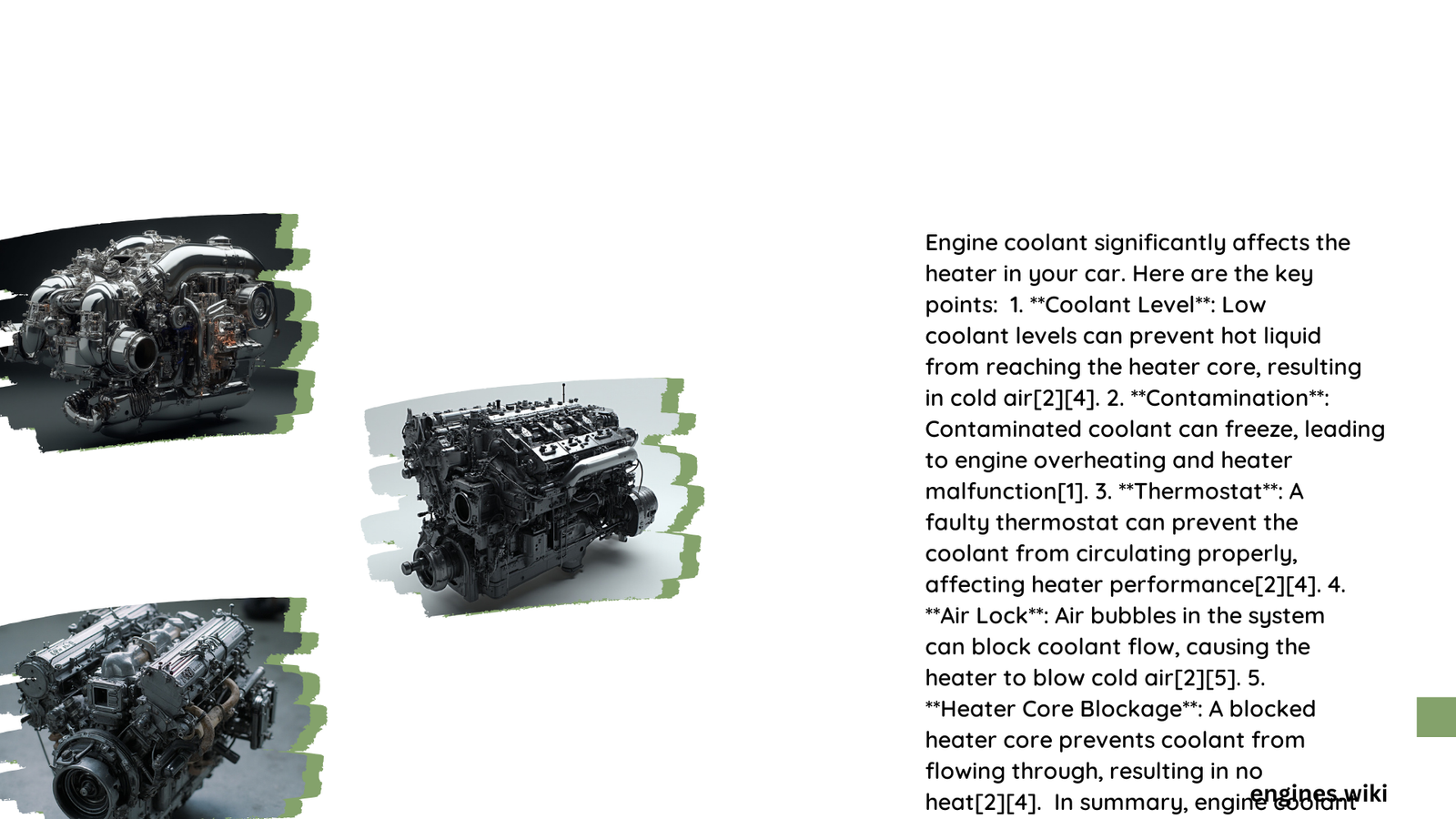Engine coolant plays a crucial role in a vehicle’s heating system. It directly impacts the heater’s efficiency, temperature regulation, and overall performance. The coolant’s temperature, type, and flow dynamics significantly influence how well your car’s heater functions. This article explores the intricate relationship between engine coolant and heater performance, addressing common issues and providing insights into optimal coolant management for effective heating.
How Does Coolant Temperature Impact Heater Efficiency?
The temperature of the engine coolant is a key factor in determining heater efficiency. Here’s how different temperature ranges affect your car’s heating system:
- Optimal Operating Range:
- Ideal temperature: 195°F (90°C) to 220°F (104°C)
- Maximum heat transfer to the heater core
-
Engine operates at peak efficiency
-
Low Temperature Effects:
- Insufficient heat production
- Common during cold starts or when thermostat is stuck open
-
Heater core receives inadequate heat for effective cabin warming
-
High Temperature Consequences:
- Risk of engine overheating
- Potential damage to engine components
- No significant improvement in heater performance beyond optimal range
To ensure optimal heater performance, it’s crucial to maintain your coolant temperature within the recommended range. Regular checks of your cooling system, including the thermostat and radiator, can help prevent temperature-related heating issues.
What Role Do Different Coolant Types Play in Heater Performance?

The type of coolant used in your vehicle can significantly affect heater performance. Let’s compare the two most common types:
| Coolant Type | Specific Heat Capacity | Thermal Conductivity | Heat Transfer Efficiency |
|---|---|---|---|
| Ethylene Glycol | 2.4 kJ/kg·K | 0.258 W/m·K | Higher |
| Propylene Glycol | 2.2 kJ/kg·K | 0.224 W/m·K | Lower |
Ethylene Glycol:
- Most commonly used in vehicles
- Superior heat transfer properties
- Effective at low temperatures
- Toxic if ingested
Propylene Glycol:
- Less toxic and more environmentally friendly
- Slightly less efficient at heat transfer
- May result in marginally reduced heater performance
- Safer for use in areas with environmental concerns
While both types are effective, ethylene glycol’s superior heat transfer properties make it the preferred choice for optimal heater performance in most vehicles.
How Do Coolant Leaks Affect Heater Operation?
Coolant leaks can have a significant impact on your vehicle’s heating system. Here are the key effects:
- Reduced Coolant Volume:
- Even a 10% reduction in coolant can noticeably affect heater performance
-
Less coolant means less heat transfer to the heater core
-
Impaired Engine Temperature Regulation:
- Engine may run hotter than optimal
-
Risk of overheating and potential engine damage
-
Decreased Heating Efficiency:
- Heater core receives less hot coolant
-
Cabin takes longer to warm up or may not reach desired temperature
-
Pressure Loss in the Cooling System:
- Can lead to air pockets forming in the coolant lines
- Further reduces heat transfer efficiency
To maintain optimal heater performance, it’s essential to regularly check for coolant leaks and maintain the proper coolant level in your vehicle.
What Impact Does Coolant Flow Have on Heater Core Performance?
The flow rate of coolant through the heater core is crucial for effective heating. Here’s how flow dynamics affect heater performance:
Ideal Flow Rates:
- Optimal range: 1.5 to 2.5 gallons per minute (GPM)
- Ensures efficient heat transfer without excessive pressure drops
Effects of Flow Rate Variations:
- Low Flow Rate:
- Insufficient hot coolant reaches the heater core
- Results in poor heating performance
-
Can be caused by a weak water pump or blockages in the system
-
High Flow Rate:
- Can improve heat transfer initially
- May increase pressure drop across the heater core
-
Potentially leads to increased pump load and reduced system efficiency
-
Balanced Flow:
- Allows for optimal heat transfer
- Maintains system efficiency
- Prolongs the life of cooling system components
To ensure proper coolant flow, regular maintenance of your vehicle’s water pump, thermostat, and cooling passages is essential. This helps prevent blockages and ensures the coolant can circulate effectively through the heater core.
How Can You Optimize Coolant for Better Heater Performance?
To maximize your vehicle’s heater performance, consider these coolant optimization strategies:
- Use the Right Coolant Type:
- Follow manufacturer recommendations
-
Consider ethylene glycol for superior heat transfer
-
Maintain Proper Coolant Levels:
- Check coolant levels regularly
-
Top up with the correct coolant mixture
-
Flush and Replace Coolant Periodically:
- Follow your vehicle’s maintenance schedule
-
Prevents buildup of contaminants that can reduce efficiency
-
Check for Leaks Regularly:
- Inspect hoses, radiator, and water pump for signs of leakage
-
Address any leaks promptly to maintain optimal coolant volume
-
Ensure Proper Coolant Mixture:
- Typically a 50/50 mix of coolant and water
-
Provides optimal freeze protection and heat transfer properties
-
Monitor Coolant Temperature:
- Use an OBD-II scanner to check coolant temperature
- Ensure it’s within the optimal range for your vehicle
By following these optimization strategies, you can ensure that your engine coolant effectively supports your vehicle’s heating system, providing comfortable cabin temperatures even in the coldest weather.
In conclusion, engine coolant significantly affects heater performance. From temperature regulation to flow dynamics, every aspect of your vehicle’s coolant system plays a role in how effectively your heater operates. Regular maintenance and attention to your cooling system can ensure optimal heater performance and a comfortable driving experience in all weather conditions.
References
- https://www.caltech.edu/about/news/question-week-why-does-engine-cooling-system-have-thermostat-and-hos-does-it-relate-coolant
- https://forums.tdiclub.com/index.php?threads%2Fcoolant-temperature-and-mpg.299008%2F
- https://www.fiatforum.com/threads/relationship-between-coolant-temperature-sensor-and-thermostat.332949/
